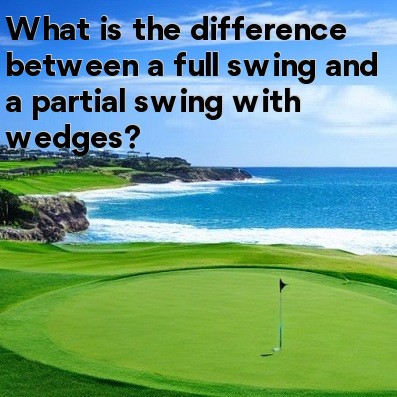
Difference Between Full Swing and Partial Swing with Wedges
Golfers often encounter situations on the course where they need to adjust their swing based on the distance they want to hit the ball. This is particularly true when using wedges, which are shorter clubs that are typically used for approach shots and shots near the green. Understanding the difference between a full swing and a partial swing with wedges can greatly enhance a golfer's performance.
Full Swing
A full swing with wedges, as the name suggests, involves taking a complete swing from the backswing to the follow-through. The objective is to generate maximum power and distance with the wedge. In a full swing, the golfer starts with a relaxed grip and positions the ball slightly forward in the stance. The backswing is controlled, allowing the wrists to hinge naturally, and the body weight shifts smoothly to the back leg. As the golfer transitions into the downswing, the hips rotate, and the hands lead the clubhead towards the ball. At impact, the golfer strikes the ball with a descending blow, maximizing spin and control.
A full swing with a wedge is generally used when the golfer needs to hit the ball a significant distance, typically when the target is farther away. The golfer may need to take into account factors such as wind direction, hazards, and the desired ball flight. Distance control and accuracy are crucial in executing a full swing with a wedge.
Partial Swing
A partial swing with wedges involves making a shorter swing to hit the ball a specific distance. This type of swing is employed when the golfer wants to hit the ball a shorter distance, such as when playing a pitch shot or when faced with a tight lie near the green. The golfer adjusts the length of the backswing and follows through, depending on the desired distance.
During a partial swing, the golfer typically uses a more narrow stance and places the ball slightly back in the stance. The grip may also be adjusted slightly, depending on personal preference. With a shorter backswing, the focus is on controlling the clubhead speed and maintaining a smooth tempo. The weight shift is more subtle, and the wrists remain relatively firm throughout the swing. The goal is to strike the ball cleanly and establish the desired trajectory.
When executing a partial swing with wedges, the golfer must pay close attention to distance control and accuracy. Since the swing is shorter, precision becomes even more critical, especially when trying to land the ball close to the target or navigating obstacles on the course.
Conclusion
The difference between a full swing and a partial swing with wedges lies in the length of the swing and the distance achieved. While a full swing allows for maximum power and distance, a partial swing offers more control over shorter distances. Both types of swings are important for golfers to master, as they provide versatility in various on-course situations.
By understanding and practicing both full and partial swings with wedges, golfers can effectively adapt to different distances and enhance their overall performance on the course.





